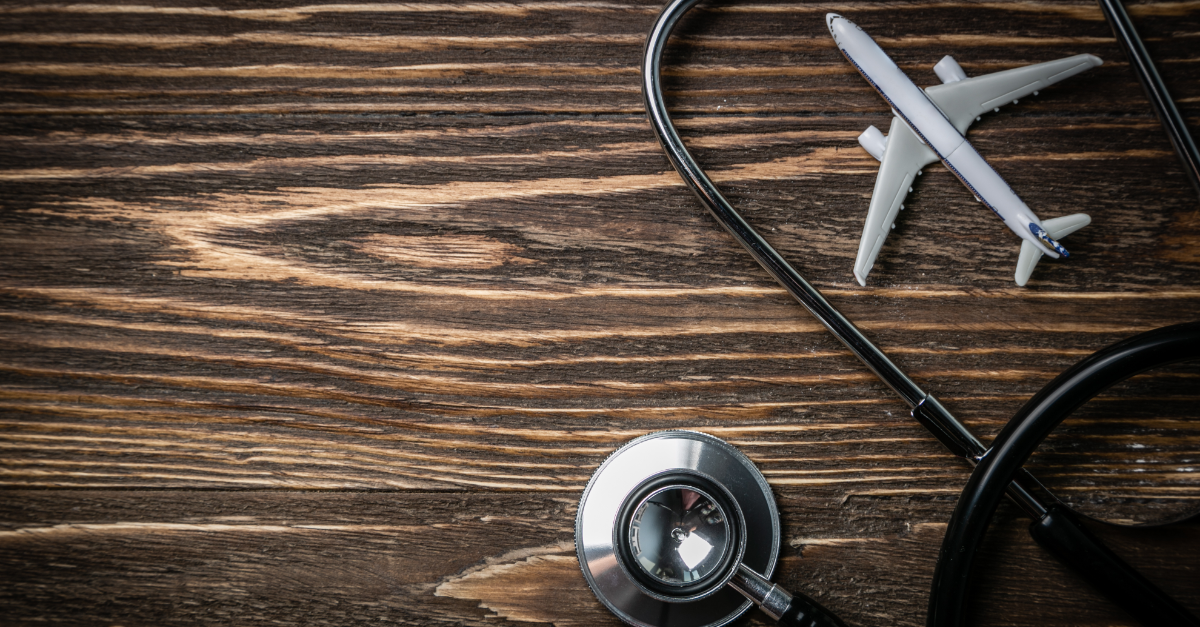Last Updated on July 21, 2022 by Laura Turner
We’ve all seen it on TV and movie screens: A medical emergency occurs on an airplane and the crew asks if there is a doctor on board. But what do you need to know if an in-flight emergency happens on your flight? Are you obligated to help? What equipment is available on the plane?
Before the pandemic, my husband and I were on a red-eye flight back to visit Lexington, Kentucky. As we were settling in, the lady in the aisle seat next to me and I joked about her poor freshly baked cookies getting crushed in her overhead baggage.
I managed to close my eyes and get a few hours of sleep when the cabin lights suddenly came on. The flight attendant’s voice came over the speaker: “Will someone with medical training – physician, nurse, EMS – please come to the back galley to assist?”
My internist medicine husband and I hurried to the back galley, where we found the same lady that had been seated next to me lying on the floor. As soon as we positioned an oxygen mask on her, she lost consciousness, her legs became stiff, and she began shaking – she was having a seizure. We immediately placed her on her side as the very calm and capable flight attendants began to ask us what we needed. At that point, we were asked if we thought the plane needed to make an emergency landing.
In-Flight Emergencies
So, what should you do if you are ever faced with a medical emergency on an airplane?
First of all, take a deep breath. It’s a scary situation, and it’s okay if you don’t feel ready or capable of volunteering. In the U.S., you are not legally obligated to assist.
When I was a first-year OB/GYN resident, I was on a delayed flight across the country when I was awoken by the cabin lights turning on and a voice over the speaker asking for medical assistance. I honestly felt I could not handle the situation so early in my training. But just as I nervously stood up, a family medicine physician came bounding down the aisle to help the patient.
But if you do choose to help and don’t have any other medical professionals to back you, allow a moment to let all your training kick in. You may be surprised at how much knowledge you have even in a stressful situation. Always remember your bedside manner, introduce yourself, and obtain a good history and physical.
Liability Concerns
But what about liability if you do choose to help?
In 1998, Congress passed the Aviation Medical Assistance Act (AMAA), protecting providers who respond to in-flight medical emergencies from liability on U.S. domestic flights and most international flights involving U.S. carriers or residents. Unless, of course, the patient can establish that the provider was “grossly negligent” or intentionally caused the alleged harm.
So if you had a glass of wine during the flight or took a sleeping pill, think twice before offering your services, especially if another medical professional volunteers.
Limited Equipment Available
What if the airplane doesn’t have the equipment you need?
Since an in-flight medical emergency was something my husband and I had never experienced before, we had no idea what supplies were available. We wanted to rule out if low blood sugar could be causing her seizure, but unfortunately, a glucose monitor was not included. And since the engine was so loud, it wasn’t easy to hear anything with the provided stethoscope. The in-flight medication box included a lot of things, including epinephrine, nitroglycerin, atropine, and aspirin. What it did not include was what we needed for a seizure – Ativan.
Keep in mind that the equipment and medications available are limited, and do the best you can. Thankfully, even though AEDs are on board and the flight attendants are trained in both its use and CPR, cardiac arrest accounts for just 0.3% of in-flight emergencies. Recognize that though you do have the position of advising that the plane make an emergency landing, the decision to divert lies solely with the pilot. It is an extremely complicated decision that factors in fuel, costs, feasibility of landing at an airport, and the available medical resources at that airport.
Luckily my seatmate’s seizure broke after (the longest) 3 minutes, and she became post ictal. When we were finally able to communicate with the passenger, she disclosed that she actually had a seizure one week prior. Fortunately, since she was seated next to me, we monitored her as we landed. Emergency medical services came on board to transport the patient as soon as we taxied.
It can be very daunting to offer help, especially if you are very early in your training or are a physician removed from hands-on patient care, such as a radiologist. But doctors and other medical professionals feel an ethical obligation to assist, and you may be the only medically trained person available to assist. And even if there are others more advanced in their careers volunteering, there’s always a chance you can lend a substantial helping hand.
And although in-flight medical emergencies only have a 0.002% chance of occurring, just 5 days later, midway through our homeward flight, the young man seated beside us in the terminal passed out in the aisle next to me.
This time, however, we were more than ready.



I’ve done this a few times over the years, including a supermarket, a gas station, and a conference at the local DEA office. There’s just not much you can do on some airlines: CPR, AED, oxygen. They aren’t set up at all for ACLS level care.
I’m surprised they actually had any medications at all in this instance but it’s been quite a while since I responded to one of these in-flight calls. There were times in-flight when I came forward and the flight attendant wanted to see “proof” that I was a doctor. I told them I’d be happy to just return to my seat because my diploma was in my checked bag.
I dealt with one seizure just with maneuvers described in the article and one vasovagal episode that looked like cardiac arrest but was cured by a painful jaw thrust maneuver while getting ready for CPR. None of the times that I rendered aid required more than basic skills, but dread trying treat an MI or CVA over the ocean with 3 hours to land.
Now I try to look like I’m asleep and see if anyone else goes to help because most of time you just end up standing over the patient looking helpless while all the passengers are waiting for you to do your doctor magic.
Thank you so much for sharing! Your response was awesome and these two comments especially made me literally laugh out loud:
“I told them I’d be happy to just return to my seat because my diploma was in my checked bag.” and “Now I try to look like I’m asleep and see if anyone else goes to help because most of time you just end up standing over the patient looking helpless while all the passengers are waiting for you to do your doctor magic.”
Great article! I’ve encountered in-flight medical emergencies (including 1 in the cockpit!) about 20 times. I’m an air warrior with over 5 million miles … ugh.
Most in-flight conditions are due to pressure differentials and reduced oxygen concentrations since the cabin is only pressurized to about 5,000 feet. GI distress (air expanding), COPD exacerbations, angina or hypoxia are examples of what I’ve come across most frequently. I’ve seen a DVT, a couple of hangover syncopies leaving Vegas, as well. I’ve done CPR 2x, once over the arctic and the passenger was declared dead after about 45 minutes and all of us being exhausted. We placed him in a business class seat in a body bag (yes, they have those on planes) and continued to our final destination in the US.
One thing of note is that the oxygen they have on board airplanes is not medical oxygen (100%). It is air, like a scuba tank. So while air might deliver oxygen at 1-2% greater than what the cabin is pressurized to, it’s not likely going to be that helpful in hypoxic conditions.
Another thing is that all airlines have their own physicians on-call on the ground. The decision to make an emergency landing, which is expensive and disruptive, is theirs. You may be asked to communicate with them by radio. If you make a good case doctor-to-doctor, they will instruct the pilots to make a landing. If the patient is stable, you’ll continue on to your final destination.
Also, airlines used to be more “thankful” to physicians helping out in medical emergencies. My first emergency, American Airlines gave me 25,000 miles, enough for a free domestic RT ticket. Lately, there is maybe a 5,000 mile bonus and a thank you email from the airline’s chief physician. But the flight crew is usually very grateful and you’ll leave with a bottle of champagne or wine and they’ll comp all your meals etc if you’re sitting in economy.
Thank you so much for your comment and especially for your information and guidance! Wow, 20 times and 1 in the cockpit. I bet that one induced even more pressure! This additional great information you provided is so helpful for all health care providers to keep in mind if they find themselves in a medical emergency.
got to do CPR between greenland and canada in 2019. full on cardiac arrest, did not make it. they didn’t have enough epi for a cardio emergency. helped place the dude in the galley and you could see the top of his head protude into the aisle for the last 3 hours of the flight. the ‘doctor’ running the code in air was in contact with ground control, the reason doctor is in quotes is the person in my situation didn’t want to administer epi for a cardiac event
0 rewards for helping except my family got to see how fast I can move when properly motivated.
stay up on your algorithms!
Thank you for your comment and sharing your experience! Agreed, stay up on your algorithms. Something I really need to do as a Radiologist!